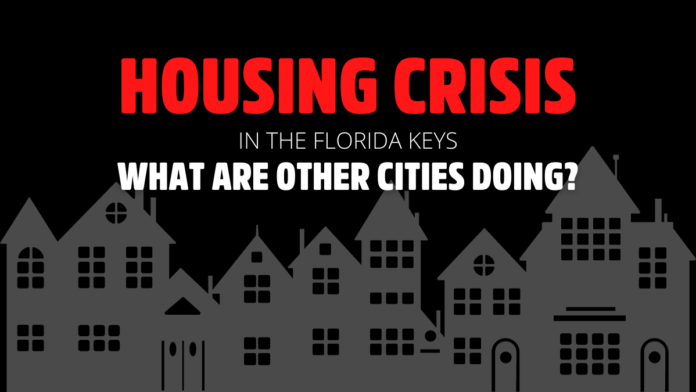By Mandy Miles and Alex Rickert
The Keys Weekly spent the past three weeks exploring the Florida Keys’ housing crisis, its causes, effects and continuing concerns. We quickly learned our island chain is by no means the only American community dealing with exorbitant housing costs, increasing vacation rentals and estates that sit empty for months.
Cures are hard to come by
“The Cape Cods and Vails of America are turning into hollow versions of their former selves. They’re losing the culture, vibrancy and authenticity that comes from real people living there — not just second-home owners commuting in from the cities on weekends and holidays,” states a report from the Institute on Policy Studies called The Housing Crisis Unfolding in America’s Destination Towns. “Addressing this problem is going to take action on two fronts: raising wages and cutting housing costs.”
Unfortunately, no community has yet found a cure for the housing crisis. There are some ideas and initiatives being proposed and attempted, but often shot down by state legislatures.
Community land trusts can help
“Innovative solutions like community land trusts are gaining popularity,” the report states. “These trusts take land out of pricey real estate markets and often enforce year-round residency requirements. That creates a way for communities from Lake Champlain, Vermont to the San Juan Islands in Washington State to ensure housing for low- and moderate-income families.”
Case Study: Martha’s Vineyard
For the six island towns of Martha’s Vineyard, help comes in the form of the Dukes County Regional Housing Authority, publicly chartered in 1986. In addition to the Island Housing Trust, one of the aforementioned community land trusts, the housing authority works to provide year-round housing opportunities for low- and moderate-income residents.
In addition to managing 101 year-round rental apartments and assisting with home ownership lotteries and affordability monitoring, the organization provides town-funded rental assistance to residents making less than 80% of the area median income who can pay a minimum of 50% of a year-round rental rate.
Private property owners enter into an agreement with both their tenants and the Housing Authority, with rents dictated by federal guidelines for the county. Tenants pay a portion of the rent directly to the property owners determined by household income, while the balance is paid to the owners from the Housing Authority.
“Fortunately, I think it’s an education of our community over the last 20 or 25 years. There are rooted people here that have homes and understand the crisis we’re in,” said administrator Terri Keech. “We’ve always touted this as a working person’s program. It’s not a free-rent ride. We do a very thorough screening of our tenants, and the landlords have always really liked that part of it.”
Keech said the long-term stability of the Housing Authority’s program is an extreme draw. “(Renters) may come up with the initial cash, but are they going to be able to sustain that?” said Keech. “(The payments) run smooth like clockwork. Landlords never have to worry about it.”
“Ultimately, the towns stepped up,” said executive director David Vigneault. “The phrase you hear over time is, ‘drive until it’s affordable.’ But we live on an island, and you can’t do that.”
Sound familiar?
Case Study: Crested Butte, Colo.
The tiny town of Crested Butte, nestled in the Rocky Mountains south of Aspen and west of Buena Vista, declared in June 2021 an emergency for the housing situation to allow the town to bypass some zoning and government bureaucracy to get housing built more quickly.
The first thing the town was able to do under the order was buy a bed-and-breakfast to be used for housing, states a 2021 Rocky Mountain PBS report, “More mountain towns taking drastic measures to address housing shortages,” which interviewed Crested Butte community development coordinator Troy Russ.
Crested Butte’s town council on July 19, 2021 also took steps toward a ballot measure that would create a second-home tax … to provide money to the town if a home is bought but left empty for the majority of the year.
“(Developers) won’t build (affordable housing) without government subsidies, period,” said Russ. “So, if we want to house our complete population, (the) government needs to reexamine its role related to housing and maybe formulate it very similarly to our interstate system.”
Case Study: Telluride, Colorado
Telluride, Colorado passed a ballot question last year that “increases the fees on business licenses for short-term rentals by about double what the current rates are. That extra money will go to the town’s affordable housing fund,” Rocky Mountain PBS reported.
Telluride town councilwoman Geneva Shaunette in 2021 suggested canceling the town’s lodging tax — which state law says must be directed toward tourism promotion — and install an excise tax on rented homes and hotel rooms that can be used for building affordable housing, the Colorado Sun reported in July 2021.
But in 2018, the report states, Colorado legislation that would have allowed county voters to allow lodging taxes for other uses did not pass.
Attitude adjustment
In a January 2018 editorial for Outside Magazine, “How to Fix the Mountain-Town Housing Crisis, Auden Schendler writes about the “old school” environmental perspective.
“Mountain communities are often run by environmentalists from 40 years ago whose thinking has not kept abreast of the development in their hometowns. They champion stasis over change, open space over density, and consider development evil. They hate crowds — even though crowds are the foundation of the entire resort economy.
“So what’s the fix?” Schendler asks. “For one, we need to embrace density,” he writes.
“Build infill housing in the urban core. … Make it dense, which means small units that go up instead of out … and enable mother-in-law units with occupation requirements.
“We should respect urban growth boundaries and oppose unmitigated sprawl. But we must also welcome changes to our towns. … We need a civics revolution, whereby younger citizens — the very ones who need housing — or enlightened elders either run for office or amp up pressure on those already in power.
“We need … a commitment to the community over self interest. We need a new YIMBYism — Yes In My Backyard — versus the current NIMBYism. We need to learn again how to live together.”






















